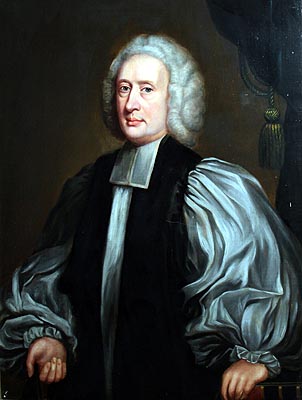Juan Gomez writes…
One of the features that we have explored in our project is the application of the experimental method in areas other than natural philosophy. I have focused on the work of George Turnbull to illustrate how the method was applied in moral philosophy and religion. In my next series of posts I want to focus on the work of Joseph Butler (who was arguably one of the figures that most influenced Turnbull) and explore his ideas on method in moral and religious inquiries.
As an introductory post to this series I will focus on the preface that appeared in the 1788 edition of Butler’s Analogy of Religion (first edition 1736) by Samuel Halifax, Bishop of Gloucester. In this preface Halifax gives an account of Butler’s ‘moral and religious systems’ that serves as a summary of Butler’s main ideas.
Halifax tells us that Butler’s moral system can be found mainly in the first three of his collection of Sermons, which are on human nature. Halifax highlights the way Butler proceeds to determine human nature:
What the inward frame and constitution of man is, is a question of fact; to be determined, as other facts are, from experience, from our internal feelings and external senses, and from the testimony of others…From contemplating the bodily senses, and the organs or instruments adapted to them, we learn that the eye was given to see with, the ear to hear with. In like manner, from considering our inward perceptions and the final causes of them, we collect that the feeling of shame, for instance, was given to prevent the doing of things shameful; compassion, to carry us to relieve others in distress; anger, to resist sudden violence offered to ourselves.
The method for acquiring knowledge of our moral system must be the same we employ to discover external facts. Halifax contrasts this method that Butler adhered himself to with the one used by Samuel Clarke. Halifax and Butler both see the two methods not as opposed to each other but rather as complementary:
The reader will observe, that this way of treating the subject of morals, by an appeal to facts, does not at all interfere with that other way, adopted by Dr. Samuel Clarke and others, which begins inquiring into the relations and fitness of things, but rather illustrates and confirms it.
It is interesting that Clarke is portrayed as following an a priori method in his moral inquiries, and I will leave the analysis of this and its relation to Butler’s method for a future post where we will examine the correspondence between Butler and Clarke regarding this issue. Since this is just an introductory post, I want to finish by showing Halifax’s rendering of Butler’s method in his religious work.
Butler’s main philosophical text was his Analogy, where he deals with natural and revealed religion and argues that the former is confirmed in the latter, both giving us evidence for the divine government of the world. The way Butler proceeds in this text is by arguing by analogy from the natural to the moral realm:
This way of arguing from what is acknowledged to what is disputed, from things known to other things that resemble them, from that part of the divine establishment which is exposed to our view to that more important one which lies beyond it, is all on hands confessed to be just. By this method Sir Isaac Newton has unfolded the system of nature; by the same method Bishop Butler has explained the system of grace; and thus, to use the words of a writer, whom I quote with pleasure, has ‘formed and concluded a happy alliance between faith and philosophy.’
One of the advantages of this method of analogy is that (as we will see in my next post where we examine Butler’s Analogy in a bit more detail) it does not lead to a claim of certain knowledge about the doctrines of religion, but it rather leads to a high degree of credibility in them. This feature allows Butler to get rid of a number of objections. Further, if the analogy Butler argues for is a strong one, then all objections made against revealed religion will also count as objections to natural religion, which is a consequence the objectors will not want to admit.
As we have seen in this brief account of Halifax’s preface, it appears that a striking feature of Butler’s work in morality and religion is the methodology he applies in both areas, one that argues from facts and experience instead of hypotheses and speculations:
Instead of indulging to idle speculations, how the world might possibly have been better than it is; or, forgetful of the difference between hypothesis and fact, attempting to explain the divine economy with respect to intelligent creatures, from preconceived notions of his own; he [Butler] first inquires what the constitution of nature, as made known to us in the way of experiment, actually is; and from this, now seen and acknowledged, he endeavours to form a judgment of that larger constitution, which religion discovers to us.
In my next post we will examine Butler’s application of this method in his Analogy and his defense of probable knowledge.


